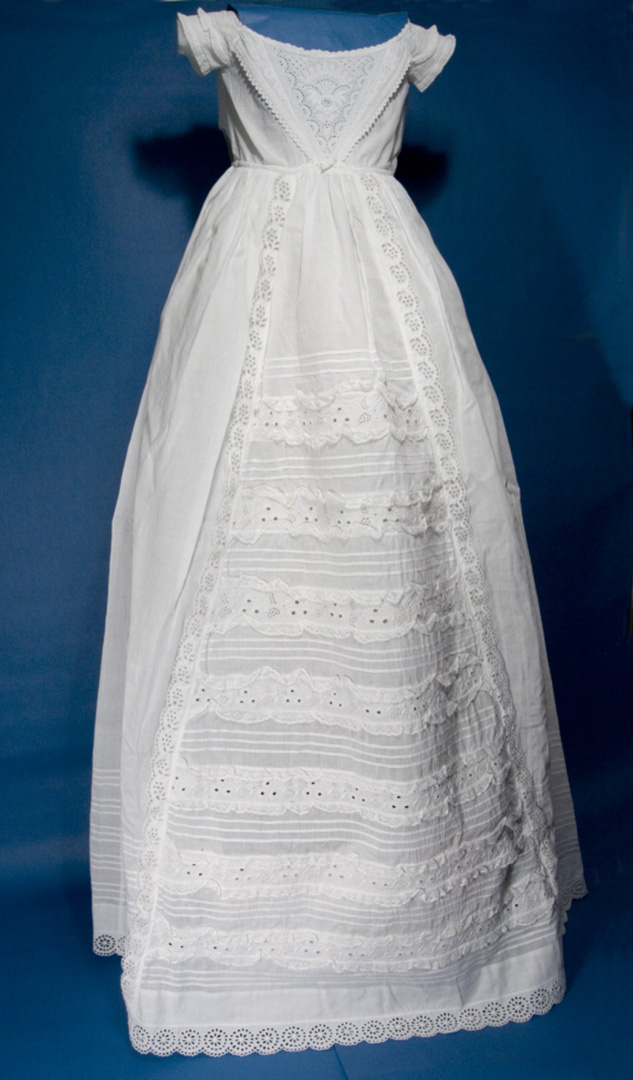Ayrshire, a county on the southwest coast of Scotland, is perhaps best known as the birthplace of the poet Robert Burns. Widely regarded as the national poet of Scotland, Burns’ birthday, on the 25th of January, is celebrated worldwide, usually with traditional “Burns Suppers,” which consist of haggis, tatties (potatoes), and neeps (turnips). But Ayrshire is also home to an exquisite style of whitework embroidery known as Ayrshire needlework.
True Ayrshire needlework consisted of white embroidery on white fabric and was worked on muslin or fine cotton lawn but never on linen. It was Scotland’s answer to the problem of expensive lace imports. Since the fabric and stitching were so delicate, it was too fragile to withstand the wear and tear that domestic textiles were subjected to, so it was reserved for special pieces, such as christening gowns, handkerchiefs, and collars.
Christening robe with Ayrshire needlework.
Women worked much of Ayrshire embroidery in their homes. The fabric they received already had the pattern stamped onto it in water-soluble blue dye, and once it was stitched, the finished embroidery would be returned to the agent where it was then washed, cut out, and made up into garments. Complex garments, such as christening robes, were made from a number of pieces and often sewn by several women who specialized in particular stitches or techniques.
Such was the popularity of the embroidery that in the 1830s over 300 women in the parish of Sanquhar in Ayrshire made their living by “flowering,” a commonly used name for the technique. Sadly, by the mid-nineteenth century, changing fashions and the advent of cheaper machine-made embroidery meant that the exquisite handsewn Ayrshire needlework was no longer viable. In her book, The Flowerers: The Story of Ayrshire White Needlework<, which provides an excellent history of Ayrshire needlework, author Margaret Swain observes that Ayrshire needlework “ . . . was born and died at the whim of fashion.”
Margaret Swain’s book on Ayrshire needlework, The Flowerers, includes an excellent history of the technique.
As you’d expect, the museums in Ayrshire have a large collection of the delicate embroideries, including the collection of the late Agnes F. Bryson, better known as Bunty, who wrote a book on the subject. I was lucky enough to meet Bunty quite a few years ago, and she showed me many of the amazing pieces that she’d collected, including pieces of embroidery that she’d made herself. In the mid-1950s, she’d attended Ayrshire needlework classes run by the Scottish Women’s Rural Institutes (SWRI) and told me that she was “addicted from the first stitch.”
Bunty researched the subject thoroughly, even unpicking some pieces to discover how they were stitched. She discovered that finding the right materials for Ayrshire work was also a problem, for at that time, the fine cotton lawn fabric was not available, and while the original threads had a matte finish, the modern threads were usually mercerized or synthetic and had a sheen. After trying various brands and weights of thread, she found that an ordinary sewing cotton gave the most authentic finish.
Agnes F. Bryson’s book, Ayrshire Needlework, was published in 1989.
Living in the heart of the area where Ayrshire needlework was once a thriving industry, Bunty made up her mind to keep the technique alive and pass on her skills and knowledge to as many people as possible. For many years, Bunty taught classes and gave talks, and in 1989, her book Ayrshire Needlework, now out of print, was published. Over the years, she also amassed a wonderful collection of Ayrshire needlework embroideries. In her will, one friend actually left her whole collection to Bunty, but unfortunately, the woman’s sons cleared out her house and threw everything in the bin.
Baby bonnet with Ayrshire needlework.
There was no way that Bunty would allow her own treasured collection to suffer such a fate, and she left it to the local Ayrshire museums, who were delighted to have it.
Bunty had passed on her knowledge to many people, including her friend Linda Fairlie, who works at the Dick Institute, a museum in Ayrshire. Linda and her colleague Bruce Morgan continue to spread Bunty’s knowledge of the subject, and they were advisors to the Victoria & Albert Museum (V&A), in London, on Ayrshire needlework for the displays in the new V&A Dundee, Scotland’s first design museum, which opened in 2018.
Christening robe with Ayrshire needlework.
Linda said, “A woman, who used to work at the Dick Institute now works at the V&A, knew that we worked closely with Bunty, so we were invited to go through the V&A collections in London and make a selection. They have lots of gowns, and we eventually narrowed it down to a choice of three. The final choice was difficult, but in the end, we all decided on the same one. It’s lovely to have a piece of Ayrshire needlework displayed in such a fabulous new museum!”
It seems that Bunty’s dedication and skill continue to ensure that Ayrshire needlework will not become a forgotten art.
—Kathy
P.S. Ayrshire christening robes have a little hole at the front where the bodice meets the skirt. The point on the bodice is tucked into the hole when the gown is worn by a girl and left out when worn by a boy, which removes the guesswork for anyone admiring the baby. A contact in Australia told Bunty that this is called the “tickle hole,” which is a piece of information Bunty had never heard before.
Kathy Troup, born in the north of England, has lived in Scotland for many years. She edited a U.K. published stitching magazine for seventeen years and continues to write about the subjects she loves.
Featured Image: Materials used to create Ayrshire needlework. Photos by permission of East Ayrshire Council/East Ayrshire Leisure, and www.futuremuseum.co.uk.






